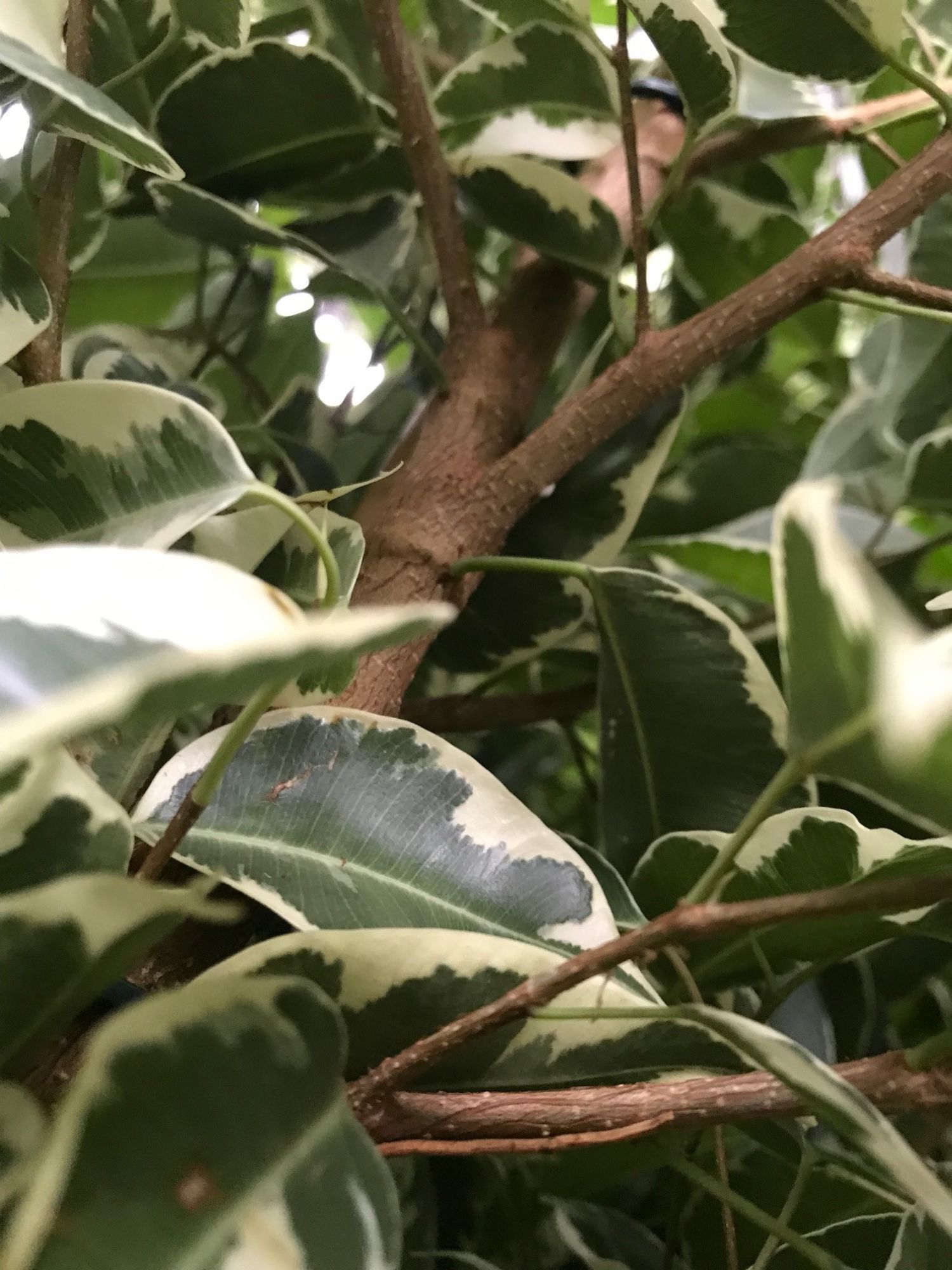
Ficus benjamina 'Variegata'
Listen to the Weeping Fig Podcast here!
Contents
- Top Tips
- Location, Water, Humidity & Fertilisation
- Common Issues
- Origins, Temperature, Propagation, Repotting & Toxicity
Need the answer to a specific plant query? Book a 1-to-1 video call with THE HOUSEPLANT DOCTOR™, the website's friendly author, to overcome and address your niggling problem! Available on iMessage, WhatsApp, Facebook Messenger & more.
Top Tips & Info
- Care Difficulty - Moderate to Difficult
- Allow the top third of the soil to dry out in between waters, reducing this slightly in the autumn and winter months.
- Provide a humid location away from operating radiators; we'd recommend introducing a pebble tray to present a reliable, steady environment. A constant level of humidity & temperature (12°C, 54°F +) is mandatory to prevent sudden leaf-loss.
- Bright, indirect light is key to quality growth. Avoid excessively dark locations as it'll significantly increase the risk of soil-mould & root rot.
- Fertilise using a 'Houseplant' labelled feed every four waters in the spring and summer, reducing this to every six in the colder months.
- Repot every three years with a 'Houseplant' labelled potting mix; be sure to respect the roots as transplant shock is a big issue that could cause wilting or even death.
- Keep an eye out for Spider Mites, Mealybugs & Whitefly that'll inhabit the plant's cubbyholes and foliage.
Thinking of repotting your Fiddle-Leaf Fig soon?
- A beautiful blend of coconut coir, perlite, bark and biochar to promote stronger roots and healthier leaves
- 100% peat-free with recyclable packaging
- Comes with a free step-by-step guide on repotting and 50% off a 1-to-1 plant-advice call with Joe Bagley
- FREE UK Delivery, regardless of the price!
SHOP NOW
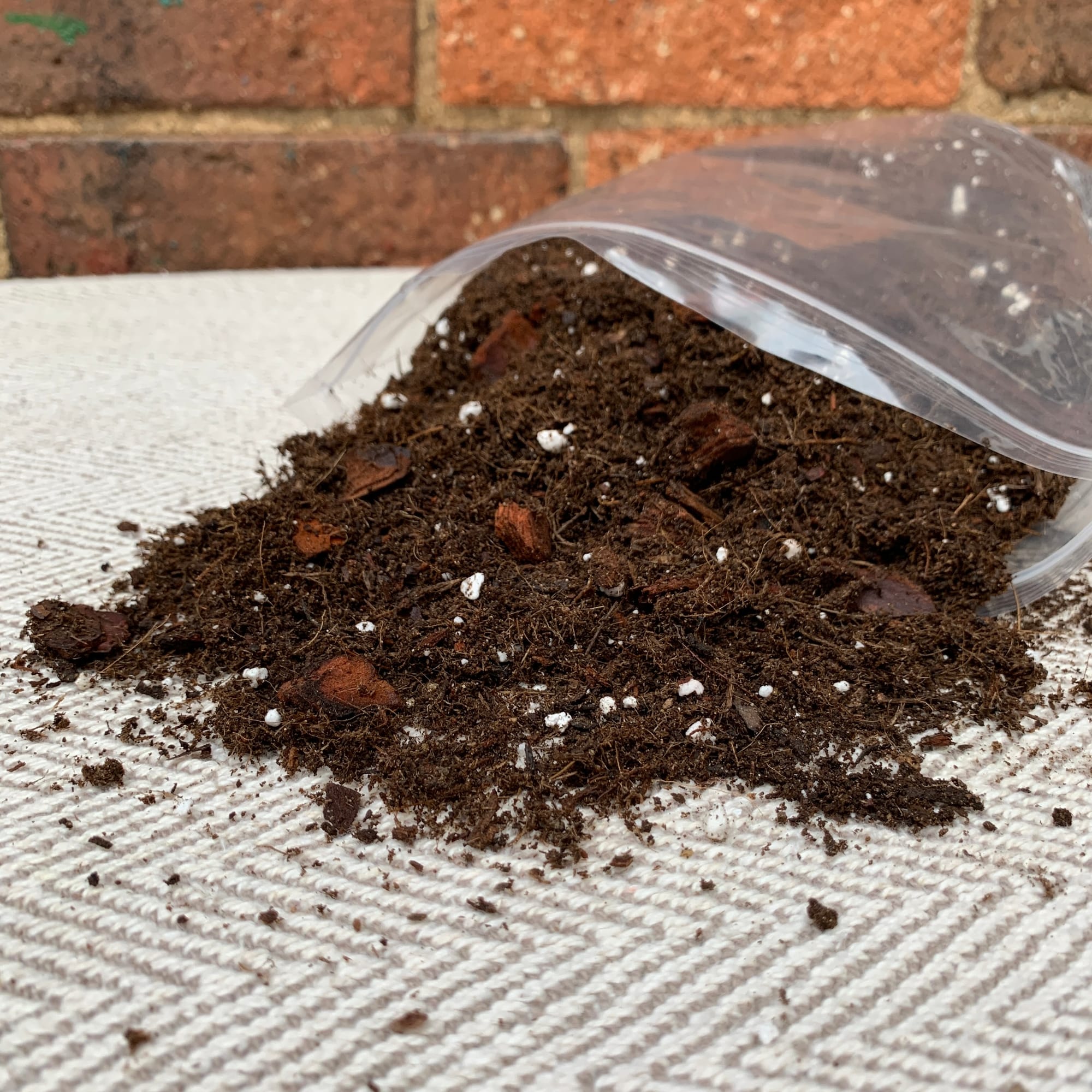 From £5.95 with FREE Delivery!
From £5.95 with FREE Delivery!
Location & Light - 🔸🔸
Perfecting the amount of light a Weeping Fig receives is crucial for a long-lasting specimen. During the spring and summer, be sure to provide a brightly lit spot away from any direct light. Excessive exposure during this time will negatively affect the plant in the likes of sun-scorch and dehydration. Once the autumn kicks in, be sure to include an hour or two of direct light per day to get it through the dormancy period.
Water - 🔸🔸
Allow the top third of the soil to dry out in between waters in the growing period, reducing this further in the autumn and winter. You'll notice that Weeping Figs are situated in a well-draining medium, meaning that standing water could be an issue beneath the pot. If possible, use lukewarm water as their root systems are super sensitive to temperature change, with potential side effects including weak summer growth and a general decline in health. Under-watering symptoms include grey or yellowing leaves, yellow spots and stunted or deformed growth. Never allow the soil to thoroughly dry out for extended periods, especially in hot spells; failure to do so could result in distorted growth that won't look appealing. Over-watering symptoms include yellowing lower leaves, rotten plant sections and a softened stem. These issues are usually due to too little light or heat, too much water in between waterings, over-potting your specimen, or standing water beneath the pot. For minor cases, be sure to change its growing environment with a brighter location and fewer irrigations. For more severe cases where the container is unreasonably heavy with prompt leaf loss, click on the following link to learn more about root rot.
Humidity - 🔸🔸
This species thrives in a stable, humid environment, meaning that a pebble tray (or frequent misting) is mandatory for success. Signs of an under-humid room are primarily similar to inconsistent fluctuations, with slowed growth, browning leaf-tips and leaf loss being the common symptoms.
Fertilisation - 🔸🔸
Feed every four waters during the growing period and every six in the autumn and winter, using a 'Houseplant' labelled fertiliser. Never apply a 'Ready to Use’ product into the soil without a pre-water first, as it may burn the roots and lead to yellowed leaves.
Common Issues with Weeping Figs
Lower leaf loss is a common and significant issue among gardeners. This unfortunate phenomenon could be a product of several different problems, most notably being dark locations, water-related abuse or environmental shock. Introduce the plant to a more well-lit area with a splash of off-peak sunlight; if caught in time, the leaf loss should stop within a week. If you feel that you're watering habits aren't up to scratch, familiarise yourself with our care tips provided at the top of this article. It's always best to under-water a Weeping Fig than over-do it, purely on its poor ability to endure continued sogginess. The final culprit could be down to a sudden relocation; if you've recently purchased the specimen, the chances are it is still acclimatising to the new environment. Although this shouldn't happen, a vastly different setting will cause sudden foliage loss and stunted growth. You'll have two options of either waiting it out or presenting a more Ficus-friendly environment, mentioned in the 'Location & Light' section. If you'd like to speak to ukhouseplants regarding a specific plant question, don't be afraid to book a 1-to-1 call with THE HOUSEPLANT DOCTOR™ to help solve it!
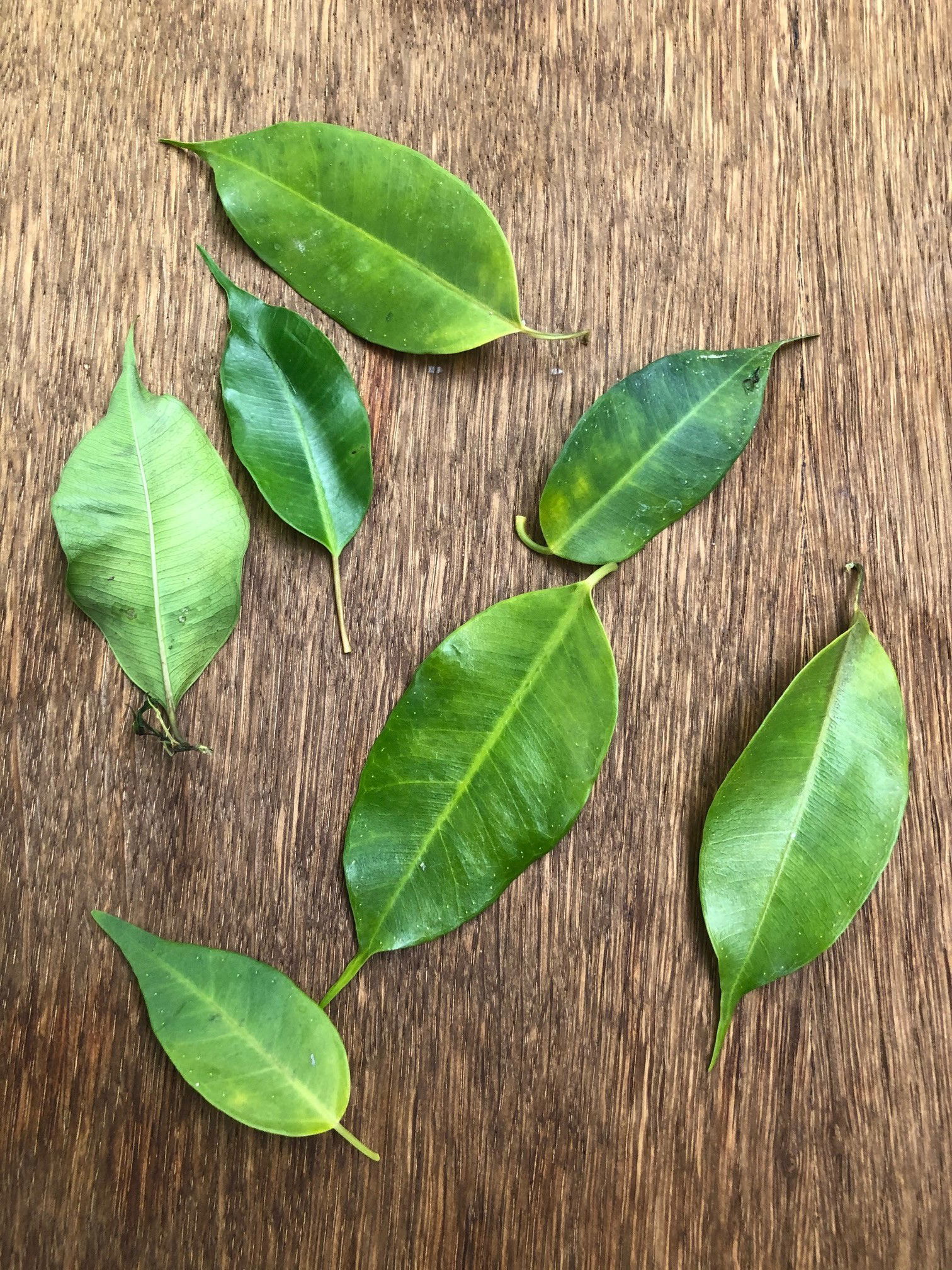 The yellowing of lower leaves is caused by an array of different issues, including over or under-watering, too little light and environmental shock.
The yellowing of lower leaves is caused by an array of different issues, including over or under-watering, too little light and environmental shock.
Root rot is another common issue with specimens sat in too moist or waterlogged soil for long periods. Symptoms include rapidly yellowing leaves, yellow or brown deflated leaf-sections, stunted growth and a rotten brown base. Take the plant out of the pot and inspect health below the soil line. If the roots sport a yellow tinge, you're good to go, but if they're brown and mushy, action must be taken immediately. More information about addressing root rot can be found on this link or scroll down to the bottom to see a healthy root system example.
Yellowing lower leaves (closest to soil) are a clear sign of over-watering, usually caused by too little light. Although Ficus can just about do well in a shaded environment, the frequency of irrigations must be reduced to counteract the chance of root rot. People don't realise that a plant's root system needs access to oxygen too; when soil is watered, the air will travel upwards and out of the potting mix. A lack of available oxygen for the roots will cause them to subsequently breakdown over the oncoming days. In some cases, however, lower yellowing leaves could be the product of dehydration and prolonged soil dryness, commonly caused by too high temperatures or sun exposure. Click on this link to learn more about root rot and how to address it.
Always use lukewarm water, and if you choose to use tap water, allow it to stand for at least 24hrs before application. Weeping Figs tend to be somewhat sensitive to temperature change, so pouring cold tap water immediately into the pot will not only shock its roots, but it could even cause yellowing leaf-edges over time.
Curled leaves and brown leaf-edges are the result of too little water and over-exposure to the sun. Most Ficus are best located in bright, indirect settings, and those that haven't acclimatised to the harsh rays will show signs of sun-scorch and environmental shock. A splash of winter sunlight is acceptable as long as the soil moisture is regularly observed, with complete avoidance once summer comes along.
Never allow temperatures to dip below 12ºC (54ºF) as irreversible damage will occur in the likes of yellow foliage and weakened health. When this happens, remove the severely affected areas and immediately improve growing conditions - never cut through softened yellow growth, and only around brown, crispy squares. As rehabilitation can take several months because of its slow-growing nature, be sure to provide a stable location with better growing conditions to speed this process.
Ideally, variegated (multicoloured) plants shouldn't be kept in a darker area due to the risk of lower rates of photosynthesis. Although this may sound harmless, prolonged low rates will gradually result in weakened health, as the plant won't convert enough light into storable energy. Common symptoms of this include stunted growth, lower leaf loss and a lack of variegation on its new leaves.
Pests could arise at any time, with infestations starting from the original nursery or via contamination in your home. Spider Mites and Mealybugs tend to be the usual inhabitants, with the first being minute and almost transparent, roaming the leaves in search of chlorophyll and a site to hide its eggs. The latter, however, will stand out much more, with white cottony webs developing across the foliage and stems. Thoroughly check the plant's cubbyholes before giving it the all-clear, or click on the appropriate links to learn more about eradicating these issues.
A further pest to look out for is Whitefly. Although these small airborne critters shouldn't produce too much damage, an infestation must be destroyed quickly to reduce the chance of them spreading. Click on this link to learn more about addressing these issues.
The yellow spots that form along the outer edges of the leaves are called cystoliths; they are entirely harmless to your Ficus and will form once the leaf hardens & matures.
Origins
Ficus is a pantropical genus consisting of over 800 species, first described by Carl Linnaeus in 1753. The species, F. benjamina, was classified fourteen years later, with Linnaeus referencing its name to the Hindi synonym of 'Banjan'. The Weeping Fig is the official tree of Bangkok, Thailand.
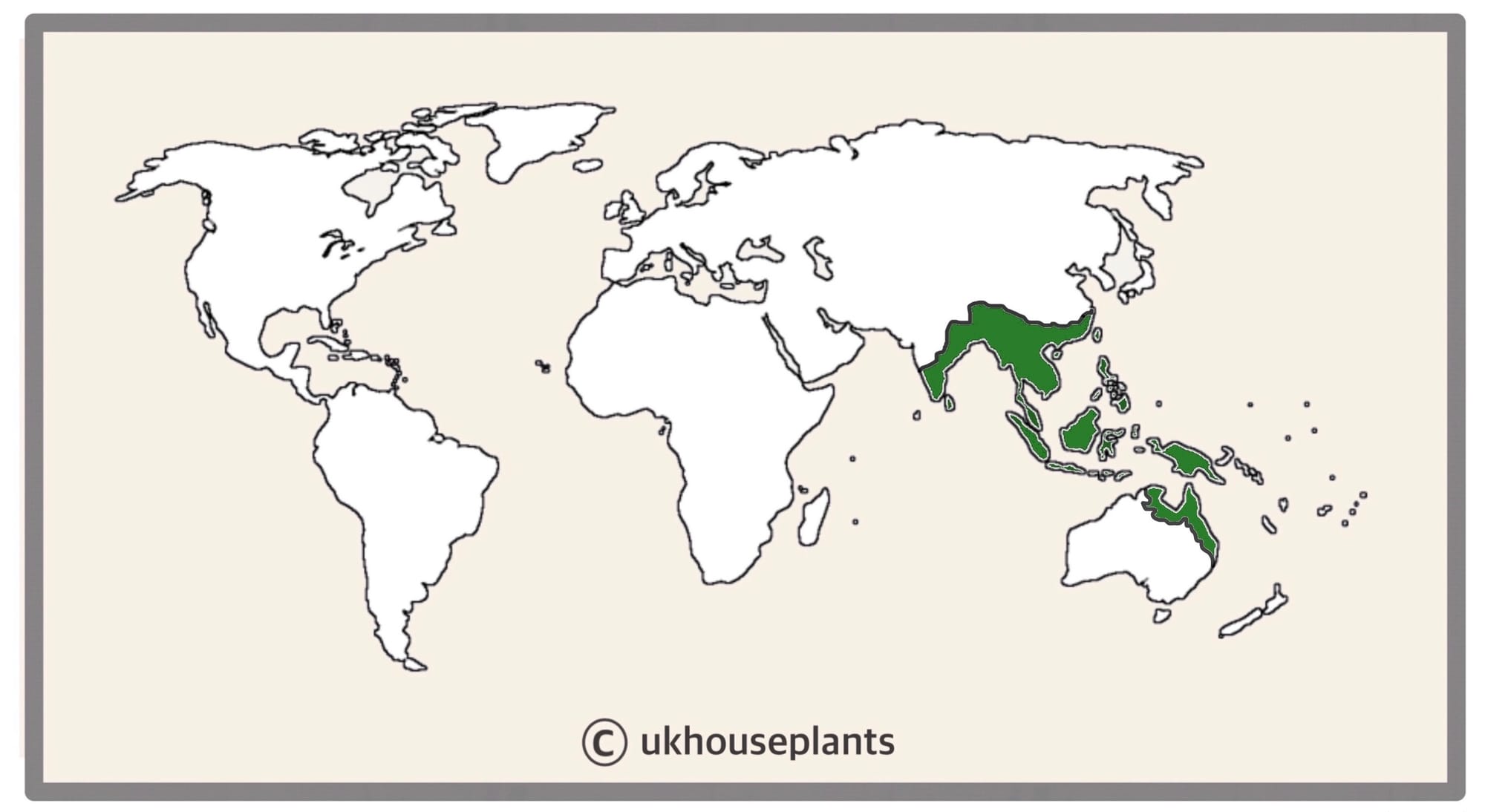 The Distribution of The Weeping Fig
The Distribution of The Weeping Fig
Temperature
12° - 26°C (54° - 80°F)
H1b (Hardiness Zone 12) - Can be grown outdoors during the summer in a sheltered location with temperatures above 12℃ (54℉), but is fine to remain indoors, too. If you decide to bring this plant outdoors, don't allow it to endure more than an hour of direct sunlight a day as it may result in sun-scorch and dehydration. Regularly keep an eye out for pests, especially when re-introducing it back indoors.
Spread
Up to 3m in height and 2m in width. The ultimate height will take around 10 years to achieve, with 12cm of growth per season.
Pruning & Maintenance
Remove yellow or dying leaves, and plant debris to encourage better-growing conditions. While pruning, always use clean scissors or shears to reduce the chance of bacterial and fungal diseases. Never cut through yellowed tissue as this may cause further damage in the likes of diseases or bacterial infections. Remember to make clean incisions as too-damaged wounds may shock the plant, causing weakened growth and a decline in health.
Propagation
Via Seed, or Stem Cuttings.
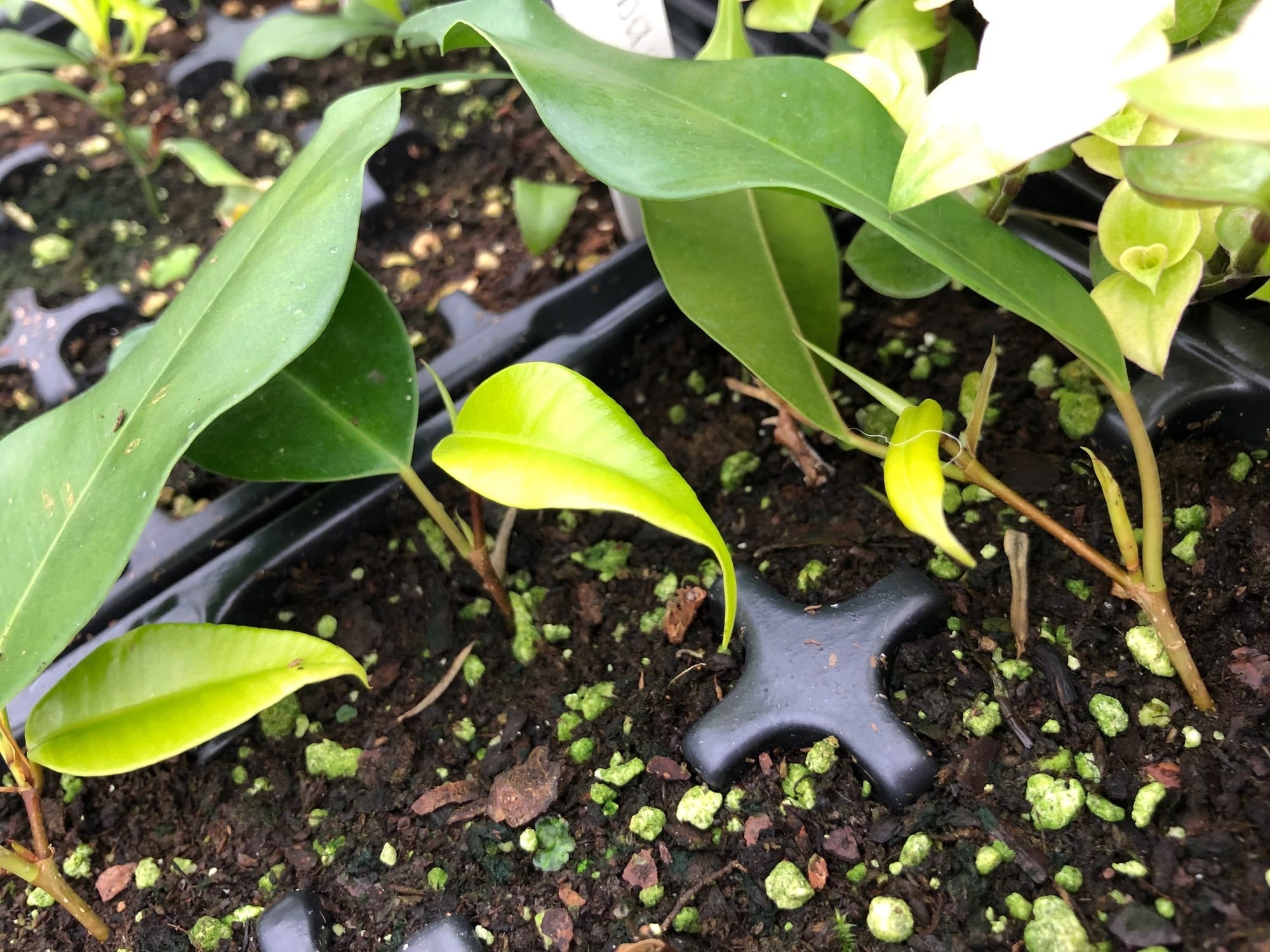 Successful rooting should take place within six weeks & is best done via 'Stem & Eye' cuttings.
Successful rooting should take place within six weeks & is best done via 'Stem & Eye' cuttings.
Stem & Eye Cuttings (Moderate) - This method of propagation is troublesome without the aid of bottom-heat and a controlled environment. Choose the healthiest, most established stems that are wooded, yet still juvenile enough to bend slightly, being just thicker than a pencil. Each cutting should only have ONE leaf, and a small portion of the stem to either side of the node. Cut directly below a node using a clean knife to reduce bacteria count. Situate the cutting into moist 'Houseplant' compost, with the only the leaf sticking out of the soil. 'Blackleg' can occur when the bottom wound becomes infected, resulting in propagation failure - typically caused by water-logging or a too-damaged wound. Maintain bright light and evenly moist soil with the avoidance of direct sunlight or cold draughts. Wrap the pot (& foliage) in a transparent bag or within a miniature greenhouse, and provide bottom hear of temperatures above 18°C (54°F). Remove the bag and place into individual 7cm (3 inches) pots once the second new leaf emerges. Follow the same care routines, as mentioned in the article's top half. This method will take up to five months, so patience and the correct environment are paramount for success!
Flowers
Weeping Fig inflorescences consist of white flowers developing in early springtime that can vary in size. This period will last up to several weeks and will from berries if pollination is successful. Unfortunately, all Ficus are highly unlikely to flower if grown domestically, due to the incorrect environmental conditions found in a typical home.
Repotting
Repot every three years in the spring, using a 'Houseplant labelled compost and the next sized pot with adequate drainage. Hydrate the plant 24hrs before tinkering with the roots to prevent the risk of transplant shock. For those that are situated in a darker location, add a thin layer of small grit in the pot's base to improve drainage and downplay over-watering. Click here for a detailed step-by-step guide on transplantation, or via this link to learn about repotting with root rot.
Book a 1-to-1 video call with THE HOUSEPLANT DOCTOR™ if you'd like a personal guide to repotting your houseplant. This will include recommending the right branded-compost and pot size, followed by a live video call whilst you transplant the specimen for step-by-step guidance and answer any further questions!
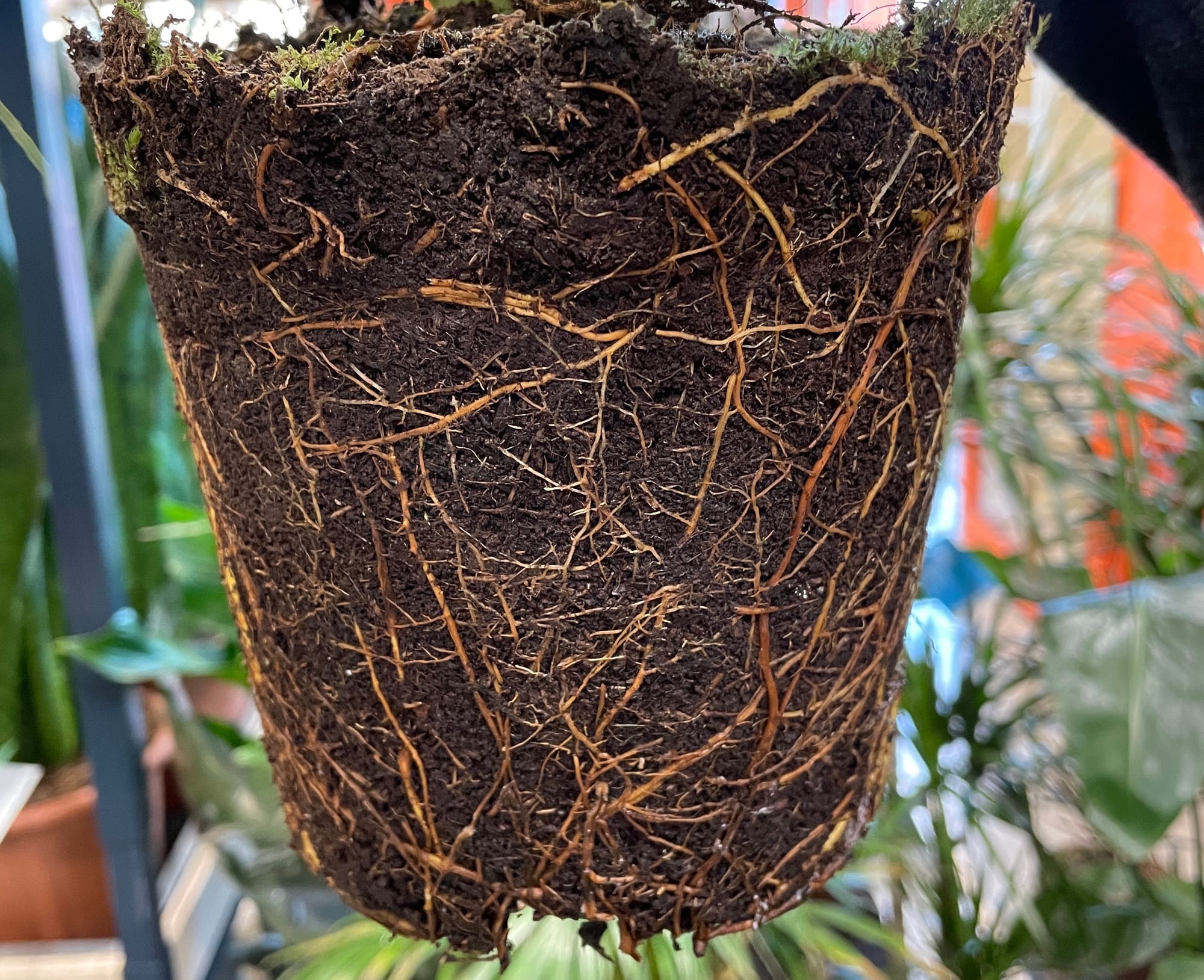 Here's an example of a Weeping Fig's root system.
Here's an example of a Weeping Fig's root system.
Pests & Diseases
Keep an eye out for mealybugs, aphids, spider mites, scale, thrips, whitefly & root mealybugs that'll locate themselves in the cubbyholes and undersides of the leaves, with the exception of the latter in the soil. Common diseases associated with Weeping Figs are root rot, leaf-spot disease, botrytis, rust, powdery mildew & southern blight - click here to learn more about these issues.
If the specimen has dry white crusty patches on its foliage or stem, this is its sap, commonly caused by damage via touch.
Toxicity
This plant is classified as poisonous; if parts of the plants are eaten, vomiting, nausea and a loss of appetite could occur. Consumption of large quantities must be dealt with quickly; acquire medical assistance for further information. The sap can also cause dermatitis and skin allergy to sensitive individuals, so be sure to wear gloves when handling.
Retail Locations
B&Q, Blue Diamond, Dobbies & Online Stores.
Book a 1-to-1 Call with THE HOUSEPLANT DOCTOR™
If you need further advice with your houseplants, book an advice call with ukhouseplants' friendly and expert writer today! This can be done via a video or audio call on most apps, including Facebook, FaceTime & Skype. A ten-minute call costs £5.99 (US$7), or £15.99 for thirty minutes. You can ask multiple questions, including queries on plants, pests, terrariums, repotting advice and anything in between. Please consider supporting this service to keep ukhouseplants thriving!